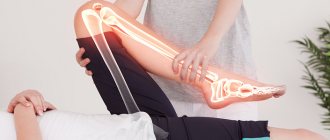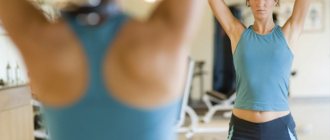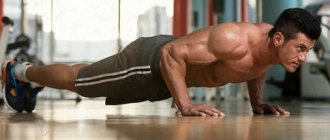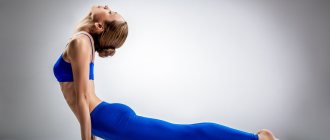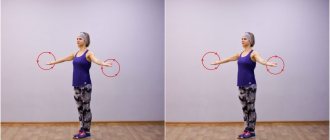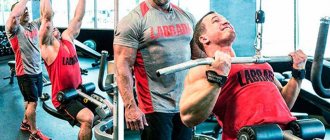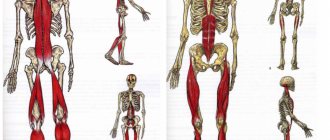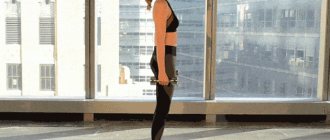Our back is a complex muscle group. In terms of quantity, it is second only to the legs. Almost all athletes know the names of the main muscles - rhomboids, latissimus, trapezius, deltoid and lumbar. They work purposefully and persistently to create strong back muscles. To obtain an expressive relief, it is not enough to highlight only the main muscles of the torso. To get an athlete's figure, you need to include and work out the serratus muscles. They are classified as small muscle groups and are located on the sides of the chest. Of course, during training the serratus muscles are indirectly involved, but they are not worked enough to achieve an effect.
How to pump up the serratus muscles
In bodybuilding, as in many sports, aesthetics and ideal body proportions are important.
Many people forget about this and just chase muscle mass. Now let's look at a small muscle group located on the ribs, called the serratus muscles. Although they are small in volume, they play a significant role in the overall picture. Relief and voluminous muscles on the ribs perfectly emphasize pumped up abs. To understand how to pump up the serratus muscles, you need to understand at what points they work. Having studied the anatomy and basic functions in detail, you will understand that it will not be possible to select targeted exercises for the serratus, they simply do not exist. They actively work only in certain movements, for example, pumping the pectorals and deltoids. The serratus muscles cannot be pumped up with isolated movements, but there is a group of exercises that load them as much as possible.
Home alternative
Many novice athletes wonder how to pump up the serratus muscle at home? Start with a home horizontal bar. Even a homemade crossbar is perfect for this purpose. You can install it in the doorway. In addition, there are now many sporting goods available in stores and online. There you can choose options that suit you. Buy dumbbells for home workouts. Use them to perform diagonal twists. Push up from the floor without lifting your elbows from your body. With the help of these simple exercises and sports attributes, you can combine your own program to pump up these auxiliary muscles.
Well-pumped serratus muscles perfectly emphasize and complement the relief of the press. They also help support the spine during axial loads. Make your training varied. Properly combine exercises to pump up different muscle groups. Don't neglect small muscle groups. And as a result, your body will look harmonious.
There are a lot of different muscles in the human body. In particular, there are those on the back that allow the ribs to rise and fall.
With certain diseases of the spine, characteristic pain is felt at the location of the serratus back muscles. To eliminate the symptoms of the pathology, special treatment is provided.
general characteristics
In the spine area, parallel to the ribs, there are two thin and flat muscles - the serratus dorsi. They are the connecting link between the intercostal muscles and the pectoral muscles.
With the correct development of the serrated organs, consisting of muscle tissue, any of their bundles will be clearly visible.
Muscles should be distinguished:
- upper posterior dentate,
- lower serrated
The place where the serratus posterior superior muscle of the back is directly located is the area under. It originates from where the spinous processes of the vertebrae are present - I-II thoracic and VI-VII cervical.
Attachment to the back of the II-V ribs is carried out using four teeth (branches), while the serratus superioris muscle is located in the direction from top to bottom along an oblique line.
The second type begins at the location of the spinous processes of the vertebrae - XI-XII thoracic and I-II lumbar. At the very beginning, the lower posterior serratus dorsi muscle looks like a tendon plate, like the previous organ.
The posterior muscle is attached by separate branches to the IX-XII ribs.
Both the first and second organs take an active part in the respiratory process. The task of the upper muscle is to raise the ribs, the lower, in turn, lowers them.
With the simultaneous action of these organs, the chest expands.
Upper muscle lesion
When osteochondrosis of the upper thoracic vertebrae occurs, doctors diagnose serratus superioris syndrome. The pathology may be accompanied by dull and deep pain in the area:
- upper edge of the scapula,
- shoulder,
- triceps muscle.
Such signs can be taken as a manifestation of compression of the nerve roots. True, no neurological disorders are detected.
On palpation, thickening and painful discomfort are felt. The patient may feel pain in the chest.
An external examination will show that the roundness of the shoulders is absent, as happens when the rhomboid and pectoralis major muscles are affected. The shoulders and shoulder girdle area are not limited in movement.
Physical activity has practically no effect on the intensity of manifestations. However, if you lift weights in such a way that the shoulder blade presses on the affected area, the pain will intensify.
To make a diagnosis, the doctor uses the palpation method. The patient, sitting on a chair, should bend slightly. The arm that is on the side where the examination is being carried out should hang freely.
Or you can place the hand in the muscle cavity on the opposite side to fully abduct the shoulder blade.
Elimination of the syndrome is carried out using:
- post-isometric relaxation,
- ischemic compression.
When using the second method, the patient is allowed to both sit and lie, turning onto his stomach.
Lower muscle damage
The serratus inferior dorsi muscle may lose its function when the upper and lower thoracic vertebral segments are affected. Location of pain:
- lower back,
- area of the lower ribs.
This symptom is characterized by aching, chronic nature. Due to severe tension, movements of the thoracolumbar region are limited.
If such signs appear, the spinal column and chest organs must be examined to exclude the development of pleurisy.
Palpation helps identify tender, painful areas in the area where the muscles connect to the ribs.
To treat the syndrome, the same methods are prescribed as in the previous case.
When performing post-isometric relaxation, the patient can sit or lie on his side. If the patient is sitting, do the following:
- By moving the shoulder forward, the doctor first stretches the muscle. At the same time, the patient’s torso is slightly bent so that there is a slight and comfortable feeling of tissue tension. Getting used to stretching lasts approximately 3-5 seconds.
- The patient should inhale smoothly and slowly, and then, stopping breathing, try to assume a neutral position. In this case, there is slight resistance on the part of the specialist. The effort required is minimal.
- A slow exhalation is made, the back relaxes, and the doctor performs a passive stretch with an increase in the initial displacement of the body.
- The procedure should be carried out without stopping 4-6 times.
To perform ischemic compression, the patient must lie on his stomach or side. In the first case, the specialist will slide his thumbs over the muscle.
If a very painful point is identified, then a slow deep massage is performed in this place.
As medical practice shows, the effectiveness of treatment increases when ischemic compression is performed before the stretching procedure.
All back muscles have their own purpose. And if problems arise with them, unpleasant manifestations will not take long to appear. To ensure your back always remains healthy, you need to consult a specialist in time.
Advanced pathologies require long-term treatment and often result in complications. Therefore, you should pay attention to the slightest discomfort in the back and follow all medical instructions.
Denial of responsibility
The information in the articles is for general information purposes only and should not be used for self-diagnosis of health problems or for therapeutic purposes. This article is not a substitute for medical advice from a doctor (neurologist, therapist). Please consult your doctor first to know the exact cause of your health problem.
I will be very grateful if you click on one of the buttons and share this material with your friends :)
In bodybuilding, as in many sports, aesthetics and ideal body proportions are important. Many people forget about this and just chase muscle mass. Now let's look at a small muscle group located on the ribs, called the serratus muscles. Although they are small in volume, they play a significant role in the overall picture. Relief and voluminous muscles on the ribs perfectly emphasize pumped up abs. To understand how to pump up the serratus muscles, you need to understand at what points they work.
Having studied the anatomy and basic functions in detail, you will understand that it will not be possible to select targeted exercises for the serratus, they simply do not exist. They actively work only in certain movements, for example, pumping the pectorals and deltoids. The serratus muscles cannot be pumped up with isolated movements, but there is a group of exercises that load them as much as possible.
Anatomy and function of the serratus muscles on the ribs
Located in the front of the chest, the upper part of the serratus is covered by the pectoral muscle, and the lower part is on the surface of the ribs. The muscle fibers are directed backward and upward, covering the outer surface of the ribs and passing under the shoulder blade. Performs the following functions:
- Moves the scapula forward and outward;
- With the participation of other muscle groups, raises arms above the horizon line;
- Promotes chest expansion.
Considering the functions performed, we can assume how to pump up the serratus muscles, namely, which exercises are more suitable for these muscles. In training, you need to do movements that are physiologically characteristic of them. Now you need to determine how the serratus anterior muscle swings; the exercises will be aimed at pumping the pectorals, deltas and back. As you understand, it will not be possible to isolate and pump up the serratus muscles alone; they work as an additional muscle in various exercises.
How to pump up the serratus anterior muscle
No matter how strange it may sound, it is believed that the best pumping of the serratus muscles occurs during the process of posing. The Latissimus pose statically loads the target muscle. Let's take a closer look:
- Take the correct position - feet shoulder-width apart, stand straight, rest your hands on the sides of your body;
- The whole process will develop in the upper body. Start by tensing your latissimus dorsi while simultaneously arching your lower back and pushing your pecs forward;
- First, the shoulder girdle will move back and then forward along with the elbows;
- The shoulder blades should be spread out to the sides as much as possible.
Having felt the maximum tension, you need to maintain it and hold it for as long as possible. It is at this moment that the serratus muscles on the ribs receive maximum static load. Do at least three of these repetitions, stretching after each time to relax all muscle groups. Here is an example of how to pump the serratus muscles by posing
It is clear that a small number of athletes will suffer from such an exercise, while the rest need to tie the training to the hardware.
How to pump up serratus muscles with weights
There are a huge number of exercises that include stress on the rib muscles. For a general understanding, we list them all in main groups:
- Bench press. Any pressing exercise for the pecs helps develop the serratus. The inclination of the bench can be different, as can the choice of equipment, even in a simulator;
- Wiring. Any incline of the bench will engage the target muscle, use dumbbells, a cable machine or a butterfly;
- Press up. Any deltoid press pumps up the serratus. Whether you use a barbell, dumbbells, machines, or special techniques like the Arnold or Bradford press, all of this involves gears;
- Standing flyes and rows to the chin.
In fact, the entire complex aimed at pumping up the chest and shoulders can pump up the serratus muscle, even at home. There is one exercise called a pullover, it makes the muscle in question work the hardest. Having understood it, you will increase your knowledge of how to pump up the serratus muscles on the ribs, and you will be able to use it effectively.
There are various techniques for performing a pullover: with dumbbells, a barbell, an incline bench, straight arms, and so on. Let's look at the classic version with dumbbells; this exercise is very valuable for young athletes, because it can make the chest deeper, which will make the pecs more attractive. The best age to get maximum effect is 15-28 years old.
The pullover is aimed at developing the pecs and includes the latissimus dorsi, triceps and serratus anterior. This exercise with additional weights strains the serratus muscles to a greater extent than the others. Therefore, it is the best and will help in achieving expressive, sculpted muscle forms on the ribs. Let's move on to the technique and take a closer look at how to pump up the serratus anterior muscle on the ribs:
- You need to place your upper back across the bench and brace yourself. Place your feet firmly on the floor with your knees at a 90-degree angle. Instead of a bench, you can use a chair, bench or fitball;
- Take a dumbbell on one side with your palms facing the plates (as in the picture) and lift it above your chest;
- Maintain a slight bend in your elbows to avoid possible injury. Position yourself so that your pelvis is below shoulder level;
- Lower the dumbbell behind your head as you inhale, maintaining a slight bend in your elbows. Lower until you feel a strong stretch in your back. The greater the amplitude of movement, the stronger the serratus anterior muscles contract;
- Use an optimal weight so you can do 12-15 reps, 3-4 sets. Raise the dumbbell in the opposite direction as you exhale.
Essence and basic principles
While the ribs protect the lungs, the muscles help the lungs expand and contract. A person uses the intercostal muscles every day to laugh, speak and simply breathe. Strengthening these muscles will increase your lung capacity and improve your respiratory system.
According to the American Council on Exercise, strengthening the intercostal muscles and diaphragm increases the efficiency of the respiratory system by expanding and strengthening the lungs. This means a person can take in more oxygen to fuel muscles during exercise and sports. These benefits apply not only to athletes, but to all people.
The intercostal muscles are located between the ribs, which means exercises should focus on these and the closest areas - the external oblique abdominal cavity, located on the sides, in the front of the torso, which extends from the last ribs to the iliac spine.
Technique for performing a pullover with a dumbbell, with a barbell and in the simulator
The material was prepared by the site team with the support of our experts: athletes, coaches and nutrition specialists. Our team >>
- Reading time: 6 min.
- Purpose of the exercise and muscles involved
- With a dumbbell
- With a barbell
- In the simulator
- Important nuances - eliminating errors
The pullover exercise (you can find a variant of the name “pullover” - from the English pull over) helps to work the pectoral muscles, affects the latissimus dorsi, and also helps to expand the chest if performed at a young age. Let's look at this exercise in detail and talk about the different options for performing a pullover with a dumbbell, with a barbell, and in a machine. And finally, we will look at the nuances that are important to take into account in order to avoid common mistakes and get the maximum result.
Purpose of the exercise and muscles involved
You won't be able to pump up your chest using the pullover exercise alone. Why do it? It has a different goal and is rather auxiliary in nature. It makes sense to do the exercise in combination with other exercises for the chest, as it promotes stretching, and most importantly, an increase in the volume of the chest. In terms of its intended purpose, it can be partly compared with the Rader thrust, also aimed at expanding the chest.
The effectiveness of such exercises varies depending on age. At a young age, when the bones and cartilage of our skeleton continue to grow and form, the most impressive results can be achieved. Indicators vary depending on the body, but on average, men grow to 20-27 years, and women to 18-20.
But this does not mean that after a certain age the situation becomes hopeless and there is no point in doing the exercise. This is wrong. The results will definitely be more modest, but you can still get valuable additional millimeters of volume, especially if you combine training with breathing squats.
To be fair, it should be said that the debate about whether doing a pullover contributes to the expansion of the chest due to the factors indicated above has not subsided to this day. There are many supporters and opponents of this point of view, who have not yet come to a common opinion.
Now let's talk about muscle function. During execution the following are loaded:
- pectoralis major muscles;
- latissimus dorsi muscle;
- triceps (mostly the long head).
The serratus anterior and intercostal muscles are also additionally involved, the diaphragm works, and the shoulders and brachialis act as assistants.
Thus, if at your age skeletal growth is no longer happening (or you think that the exercise does not expand the “bone”), doing a pullover makes sense, if only because it is simply an excellent exercise that works important muscle groups, which can be included in the final part of the upper body and chest training, both for men and girls.
Indications for use
The intercostal muscles are located in a place where they are difficult to injure. They get injured due to sudden movements, when a person suddenly bends or twists the upper body. The speed of recovery depends on the gradation of muscle tension, which indicates the degree of injury.
Muscle tension can be represented in a small table as follows:
| Voltage level | Symptoms |
| 1st degree | Low muscle tension, only some muscle fibers are damaged. Recovery time takes about two to three weeks. |
| 2nd degree | Moderate muscle tension, most muscle fibers are involved, but the muscles are not torn. Recovery time: three to six weeks |
| 3rd degree | Severe injury, complete muscle rupture. Surgery is often necessary. Recovery may take up to three months. |
Muscles are used during vigorous activities that involve twisting the torso, especially when lifting heavy objects or overextending the arms. In sports, these injuries can be caused by poor warm-up, improper execution of the exercise, or training too hard.
Exercises for the intercostal muscles will not only help you avoid injuries in this area, or recover faster from their consequences, but will also make your breathing cleaner and help you cope with shortness of breath.
When a person runs, he breathes much harder and more often than when he is not engaged in active activity. The intercostal muscles allow more air to enter the lungs. Therefore, these muscles help the body adjust to all the inhalations and exhalations required during exercise.
Without them, the body would not be able to adapt to the physiological changes that come with exercise. This is why strong intercostal muscles increase endurance and reduce shortness of breath.
The intercostal muscles are located where they are responsible for controlling breathing. Therefore, due to insufficiently developed muscles, people feel cramps, fatigue, and lack of oxygen during physical activity. Thus, strengthening the intercostal muscles has its benefits, such as improved posture and breathing.
With a dumbbell
First of all, let's look at the technique of performing a pullover with a dumbbell, as the most common and popular option. The exercise is performed lying on a horizontal bench.
Moreover, you can often find options for lying across or along the bench. It is believed that in the first case the muscles receive a greater load and are better stretched, so we will consider this one. You can be guided by your own feelings and choose the best option for yourself, since the differences in technology are minimal.
You can also sometimes find an option to perform on an inclined bench (head pointing down), in which the emphasis shifts towards the latissimus dorsi muscles. But this is rather exotic, and for training the lats you can choose much more effective and familiar exercises.
Finally, another possible variation is arms straight or bent at the elbows. Straightening the arms largely eliminates the triceps from the work, shifting the emphasis to the upper chest and back muscles: the latissimus, rhomboids and teres major.
Thoracic osteochondrosis with intercostal neuralgia: gymnastics and therapeutic exercises
Intercostal neuralgia is an unpleasant and quite painful phenomenon. There are many reasons for it, but treatment tactics are usually based on general principles. An important measure of both therapy and prevention in this case are exercises for intercostal neuralgia.
Gymnastics for neuralgia: benefits
Neuralgia pain can be caused by various reasons. This could be osteochondrosis, trauma, spasms of the intercostal muscles.
Severe pain in the intercostal spaces can be caused by pinching of the spinal nerve roots in the thoracic region due to diseases of the spinal column, including such as hernia or protrusion.
An attack of neuralgia can be triggered by staying in the same position for many hours, squeezing the nerves with the intercostal muscles.
The tone of the intercostal muscles plays an important role in the occurrence of pain.
To eliminate this problem, gymnastics is used for intercostal neuralgia, which is aimed at improving blood circulation in the muscles of the chest and back, eliminating muscle spasms, and releasing pinched nerves.
An additional task of exercise therapy is to train the muscles of the chest, giving it elasticity and strengthening the muscle corset. The complexes are selected so that they affect not only the thoracic region, but also the spinal column as a whole.
Therapeutic exercise for intercostal neuralgia: indications and contraindications
Exercises will be very useful if acute pain is caused by spasm of the pectoral muscles. If we are talking about compression of the spinal cord and spinal nerves as a result of injuries, fractures, hernias, severe curvatures and other severe pathologies, then the load, on the contrary, can cause harm.
For intercostal neuralgia, exercises should be selected individually, taking into account the characteristics of the body and physical capabilities of the patient, and the presence of concomitant diseases.
In the acute period, with severe pain, physical education is contraindicated. At this time, the patient will in any case not be able to exercise, since he will experience incredible pain under any load. Having relieved the pain syndrome through medications and other therapeutic measures, the patient can begin to perform exercises.
Preparation for exercise therapy
Gymnastics for intercostal neuralgia of the thoracic region should be prescribed by a doctor - you should not engage in amateur activities, otherwise you only risk harming yourself. Before gymnastics, it is advisable to undergo a course of professional massage to prepare the muscles for the stress. Before performing the actual complex, warm up with a short warm-up.
Also remember about proper posture and breathing. It is important that the load be gradual. Acute pain, shortness of breath, and palpitations during exercise are not allowed. Do not exercise by force; also avoid sharp bends and turns. Alternate between tensing and relaxing muscles in your exercises.
It is recommended to start by stretching the spine and relaxing the spinal muscles in a horizontal position.
Exercises to treat intercostal neuralgia at home
Exercises for the treatment of intercostal neuralgia should be aimed at stretching the intercostal muscles and spine, strengthening the spinal muscles. After the acute pain has passed, neurologists often recommend performing the following set of exercises:
- Tilts the body to the sides. Take a standing position, place your arms along your body, place your feet shoulder-width apart. Tilt your body to the left and right, gradually raising your arms and, without bending, spreading them to the sides. You need to finish the exercise in a position where your arms form a right angle with your body. In this position, the load on the pectoral muscles will be maximum.
- Squats involving postural control. They can be shallow, or you can hold onto the support with your hand.
- Exercise with fitball. Sit on the exercise ball, find your balance, clasp your hands above your head, straighten your back and bend back as far as you can. In the same position, perform smooth body turns to the sides.
- "Balance-gymnastics" . For this exercise you will need a fitball and a special stretchable rubber band. Sit on the ball, fold the ribbon in half, place the loop on your left foot, and firmly hold the ends of the ribbon in your left hand. Place your other hand on your right thigh and tilt your body to the right. As you exhale, stretch the band and lift it as high as possible above your head; while inhaling, return your arm to its original position.
Exercises need to be repeated 10-20 times. This complex can also be used to prevent intercostal neuralgia.
Exercises for stretching the muscles of the thoracic region
In the subacute period, experts recommend performing exercises for intercostal neuralgia in the thoracic region , which are aimed at stretching the thoracic region. They can supplement or replace the complex described above.
- Take a standing position, place your left hand on your chest, your right hand behind your head. As you inhale, smoothly bend to the left, raise the elbow of the opposite hand, fixate in this position, and as you exhale, straighten and relax. Change hands and repeat the exercise on the other side. Perform three approaches in each direction.
- Get on your knees, placing your palms on the floor at chest level. Press the fingers of your right hand to your collarbone. As you inhale, turn your torso to the right and point the elbow of your bent arm upward. As you exhale, lower your hand. For each side, do the action 3-4 times.
- In a similar position, place one hand behind your back and turn your body as in the previous exercise. Good to know: exercises for osteochondrosis of the thoracic spine
Yoga for neuralgia
If there is no pain, then yoga may be indicated. But it must be borne in mind that they are designed for the body of a healthy person and can provoke increased pain in neuralgia due to overstretching of the intercostal muscles. In addition, asanas require proper breathing.
For intercostal neuralgia, the abdominal type of breathing is useful, and a number of asanas involve exclusively thoracic breathing. Also, staying in an uncomfortable static position for a long time can provoke shooting pain in the chest. Therefore, yoga is allowed only when the pain has passed and the patient can perform physical therapy exercises without discomfort.
If you have neuralgia, you can practice yoga only under the supervision of an experienced specialist. Of the available asanas, the following can be recommended:
- Tadasana . For several minutes you need to stand with a straight back, arms down along the body, a tucked stomach and a straightened chest. This position helps restore energy balance in the body.
- Vrksasana . In the previous pose, you need to turn your arms with your palms facing outward. Tilt your head back as far as you can, bringing your shoulder blades together. Stay in this position for as long as you can.
- Varibhadrasana . In Tadasana pose, fold your palms and spread your legs slightly wider than shoulder-width apart. Turn your body to the side, stretch your arms up, bend one leg at a right angle, bend your back as much as possible. Stay in this position for a few seconds, then do the same in the other direction.
- Snake or bhujangasana. You need to take a lying position on your stomach, rest your palms on the floor at chest level, raise your body and bend back while inhaling, without lifting your lower abdomen from the floor. Make all movements slowly and smoothly.
Bubnovsky exercises for intercostal neuralgia
The famous kinesitherapist Sergei Bubnovsky is confident that the cause of neuralgia is idle pectoral muscles, which dry out and shorten over time, which provokes severe pain in the chest.
The specialist recommends regular push-ups and pull-ups. He also recommends the following exercises to stretch the pectoral muscles and thoracic spine:
- Pullover . An exercise that targets the pectoral and latissimus dorsi muscles. For this you will need a bench (or a bed or couch) and dumbbells or plastic bottles filled with water. Lie down on a bench so that your head hangs freely, bend your arms with dumbbells at the elbows and place them behind your head, and as you exhale, raise your arms above you to chest level. Do at least 20 lifts.
- Butterfly . This exercise stretches the pectoral muscles in width. As you inhale, bring your arms together with weights in front of your chest. Repeat at least 20-25 times.
The specialist recommends performing these exercises in one set, and then taking a contrast shower. All this will help eliminate or prevent manifestations of intercostal neuralgia.
Dikul's exercises
Therapeutic gymnastics for intercostal neuralgia using the method of Valentin Dikul has also proven itself well. Its main principle is regularity. It is necessary to systematically work out muscle groups in problem areas. For neuralgia, exercises aimed at stretching the pectoral muscles are indicated. It is recommended to perform them gradually, gradually increasing the load and preparing the muscles.
To stretch the pectoral muscles, perform the following exercises (at least 10 seconds for each):
- Stretch your arms out to the sides at shoulder level and move them back as far as possible. Lower your arms, placing them at an angle of 45 degrees relative to your body, and from the same position, move them back.
- Stretch your arms, clasp them in front of your chest, turn your palm forward, stretch forward, and then upward with your clasped hands.
- Lie on your back, bend your legs and place them on some elevation. Without bending your elbows, bring them behind your head, then return them to their original position and extend them along the body.
- In a sitting position, lower your chest to your knees. Raise your hands clasped behind your back as high as you can.
- In a sitting position, raise your bent arm, place it behind the back of your head, lower it below the shoulder blade as far as you can, pressing on the elbow with your second hand. Repeat the same with the other hand.
- In a similar position, lower your arms along your body. Lower your right shoulder and arm, reach towards the floor, while tilting your head in the opposite direction. Repeat the same for the other side.
When performing exercises, be sure to take into account which side the pain is located on. You need to start exercises exclusively on the healthy side. Connect the affected side gradually, be sure to listen to your own feelings.
Proper gymnastics for thoracic osteochondrosis with neuralgia helps alleviate the condition. But it must be taken into account that untimely exercises or too much load can only aggravate the patient’s condition and provoke a number of complications. Therefore, it is important that the exercise therapy complex is selected by a doctor, taking into account the causes of neuralgia and a number of other factors.
Source: https://www.fitnessera.ru/lechebnaya-gimnastika-pri-mezhrebernoj-nevralgii-i-grudnom-osteoxondroze.html
With a barbell
A pullover with a barbell is not much different from the version with a dumbbell. The bar is taken with a straight grip. The grip width may vary, but it is recommended to place your hands approximately shoulder-width apart, but not wider, so as not to reduce the effectiveness of the exercise.
In the case of a barbell, the most common option is to perform a pullover lying along the bench, and not across it. Make sure that your feet rest firmly on the floor and do not lift your pelvis (while moving the projectile behind your head).
Lower the bar smoothly, without jerking. The arms are lowered to approximately parallel with the floor or slightly lower.
Basic set of exercises
How to pump up the serratus muscle on the horizontal bar? Hang on the bar, the distance between your hands is 20-30 centimeters wider than your shoulders. Completely relax your back and shoulder muscles. With your leg bent at the knee, slowly and calmly lift it until you touch the opposite side of your chest. The time to hold the knee at the top point is from 4 to 6 seconds. After a while, complicate the task - try to reach the opposite shoulder. Change legs. The optimal number of visits is from 12 to 15 times. This way you will pump up the serratus abdominal muscles and also work the broad dorsal muscles.
The starting position of the next exercise is lying on a sports board or bench. Execution is the same as on the horizontal bar. As you exhale, bring your knee to your other shoulder. Hold for 3-4 seconds. Inhale – take the starting position. The number of repetitions is from 13 to 18 times. You can make the exercise more difficult by changing the angle of the bench.
Bodybuilding instructors give recommendations on how to pump up the serratus dorsi muscle. Their advice is to include the plank exercise in the basic set. To perform it, you need to take a lying position, lean on your bent elbows and toes. Stretch your body from head to heels like a string. It is very important not to arch your lower back or protrude your butt. Breathing should be deep and slow. The plank should be held for 1 to 2 minutes. The optimal option is from 4 to 6 approaches. Complicate the exercise by performing a side plank.
The exercise with a dumbbell is performed on a bench. Lying on your back, hold the projectile by one end with both hands. Bend your elbows slightly and extend them straight up. Inhale - slowly move your hands behind your head. In this case, the elbows remain in the same position. Hold your hands for 3 seconds. As you inhale, take your starting position. Do 20 – 25 approaches.
When working out at the gym, do exercises with a barbell. Stand up straight, place the barbell on your shoulders behind your head. Using the ends of the barbell, make infinity signs (“figure eights”) in the air. You need to do 4-5 figure eights in one direction. Perform 3 to 5 times.
In the simulator
Finally, there are variations of performing the exercise in the simulator - standing or sitting, and not lying down, as in the classic version. These can be simulators such as “Nautilus” or “Crossover”.
In the first case, the trajectory and amplitude of movement will be rigidly specified due to the fixed crossbar. Your back should be pressed tightly against the seat. The bar stretches down to chest level, then smoothly rises to the top position. Don’t forget to monitor your breathing: crossbar at chest level – exhale; moves to the top position - inhale.
In a crossover, there are no strict limits and the amplitude of movement can be adjusted depending on your tasks. You can adjust both the machine itself and your own position, including the distance from you to the machine.
A pullover near the block, therefore, can be aimed at developing the latissimus dorsi muscle, the upper part of the deltoids, it can affect the rhomboid and round muscles, and the triceps are excluded altogether. The technique on a block simulator as a whole can be represented as follows:
- Attach the horizontal handle to the top block. Stand at the machine so that the handle is above your head. Grasp the handle with both hands with an overhand grip. The arms are almost straight, the elbows are slightly bent, the back is straight.
- Pull the handle down by tightening your lats, keeping your back and arms straight, to approximately hip level.
- Pause for a couple of seconds at the bottom point, then smoothly and under control return to the starting position.
Reducing the range of motion at the top will allow you to practically eliminate the pectoral muscles from the work and focus on the latissimus. Depending on your goals, place the exercise at the end of your chest or back workout, respectively.
Possible lesions of the internal and external intercostal muscles and their manifestations
Among the most common problems that can arise with muscles of such localization are:
Despite the peculiarities of the location and functioning of these muscles, and the rather specific load required for their excessive stretching, such injuries still occur.
This can occur when lifting heavy weights too quickly, with significant loads on the muscles of the back and chest, especially without proper pre-warming; similar problems can also arise when swinging the arms too sharply, or when turning the body.
A sprain can be the result of a blow from some kind of sports equipment, or it can occur against the background of a strong cough.
Inflammation is an extremely unpleasant option, which can be either a consequence of stretching or occur independently due to local hypothermia, infectious or autoimmune lesions.
Characterized by almost constant pain, which intensifies with exercise. The affected area may swell, thicken, turn red, and in some cases general intoxication symptoms such as weakness and headache, as well as increased body temperature, may occur.
Spasm occurs mainly during prolonged exercise, especially when the muscles are in an unnatural position, or when the upper part of the body is in an awkward position. Severe stressful situations, depressive disorders and other similar conditions can lead to the development of muscle spasms, which can significantly interfere with normal breathing processes.
Important nuances - eliminating errors
And some final recommendations:
- Watch the sensations in your shoulder joints, because they bear a significant load. To reduce the likelihood of injury, be sure to warm up at the beginning of your workout. For the same reason, you should not immediately use too much weight at maximum amplitude. If you are an experienced athlete and are ready to work with more weight, perform fewer repetitions (5-8) and reduce the amplitude a little.
- The pullover is not the main exercise. Place it near the end of your chest training program.
- If you want to focus on the upper pecs, you can use light weights and perform the exercise with almost straight arms. The number of repetitions is high - 15 times or more.
- If you are doing pullovers in the machine, it is also not recommended to use heavy weights; focus on technique. Make sure there are no sudden movements, jerking, bending or rocking. Only the chest and back muscles work. This is an isolation exercise.
Exercises for developing abdominal muscles - Sportprofile | Sports social network
Exercises to develop abdominal muscles
If you take the trouble to study the structure of the abdominal muscles from an anatomy textbook, you will be surprised at how complex it is. Here are the rectus abdominis, external oblique, intercostal, and serratus anterior muscles.
Most bodybuilders understand the task of pumping up the abs in a very primitive way and do thousands of body lifts, considering this exercise to be the most effective.
In fact, when lifting the body from a horizontal position, only the rectus muscles work, and then only in the first third of the amplitude of movement. Next, the torso is lifted by the thigh and lumbar muscles.
The external obliques are made up of three muscle layers: the internal obliques, transverse obliques, and external obliques.
The force vector of each layer has its own direction.
Attention!
With joint efforts, they tilt the body to the sides and rotate it around its axis. Unlike the rectus abdominis, the obliques respond very quickly to high-weight, low-repetition exercises. They become massive and make the waist excessively wide.
That is why these muscles need to be trained exclusively with light weights, doing at least 50-70 repetitions per set. Indirect load when turning the body falls on the intercostal muscles.
This muscle group will work especially productively when lifting the body from a horizontal position with a turn.
Since the main function of the intercostal muscles is to ensure exhalation and bring the ribs closer together, this exercise should be performed after exhaling strongly. The serratus anterior muscles experience direct impact only in the following exercise.
You kneel down and grab the handle of the block above your head with your hands. With your elbows slightly bent, you try to “press” the handle of the block to the floor with straight arms.
It is clear that you have to do this by force of your torso tilted towards the floor. In this tilt, the serratus anterior muscles work with maximum load.
So, even the most superficial description of the abdominal muscles leads to the conclusion that the abdominal complex should include a variety of exercises.
Here are the exercise options that your complex should consist of:
Raising the torso
Main impact. This basic exercise primarily targets the upper third of the rectus abdominis muscles.
Execution method. Lie on your back and fix your feet. Bend your knees to eliminate stress on your lower back. If you try to do sit-ups with straight knees, you are sure to injure your lower back! Place your hands behind your head, clasping your fingers. From the starting position, begin to lift your torso.
First, lift your shoulders off the floor, then your upper back, your middle, and finally your lower back. Make sure that the thigh muscles are not involved in the work! Raise your torso until it reaches a strictly vertical position.
Now round your back as hard as you can, trying to bring your shoulders closer to your pelvis! Perform all movements in reverse order and return to the original state.
Options. You can make the exercise more difficult by using a special bench whose inclination can be adjusted. By raising the edge where your legs are, you will increase the load on the upper third of the rectus muscles.
Sooner or later, your own weight will not be enough to fully “pump up” your abs. Then you should take the barbell plates in your hands and do the lifts, holding them behind your head. As your skills increase, you should supplement your body lifts with alternating turns in one direction or the other. This will force the rectus and intercostal muscles to work together.
Notes. The most common mistake in the described exercise and its variations is a sharp jerk of the body at the very beginning of the movement. Raising the body, on the contrary, must be done very slowly.
Important!
Another mistake is lifting the entire body off the floor, when it needs to be lifted in parts, as if rolled up. First you need to raise your shoulders, then your back and lower back.
At the end point of the amplitude, additional emphasis should be placed on trying to lower the shoulders to the pelvis as much as possible.
Lying leg raise
Main impact. Leg raises work the rectus abdominis muscles, particularly the lower third.
Execution method. Lie on your back and grab something stationary above your head with your hands. Bend your knees and begin to lift them until your feet are directly above your pelvis. Now slowly lift your pelvis off the floor and lift it, achieving maximum contraction of the lower abdominal area. Lower your legs to the starting position.
Options. If you are using an incline bench for the exercise, raise the edge on which your head rests higher. The greater the inclination, the greater the load on the abdominal muscles. Some professionals practice the following type of exercise.
They lie down on a short bench so that its edge rests on the gluteal muscles, and their legs, slightly bent, hang down. Thus, they increase the amplitude of the exercise by lowering their legs below the position that is possible on the floor. The intensity of the exercise increases.
Notes. Lifting your legs should be done slowly, avoiding swinging movements.
Sudden leg lifts can injure your lower back! Some bodybuilders try to perform the exercise described by holding a barbell disc or dumbbell between their feet. In this case, the exercise becomes traumatic.
Sometimes you hear advice that when performing leg raises on a bench, the palms of your hands should be placed under your buttocks to reduce the risk of injury. In my opinion this is complete nonsense!
Main impact. As I already said, lifting the body from a horizontal position is truly effective only in the first third of the range of motion. This exercise limits movement to precisely this most effective area.
Execution method. You should lie as close to the gymnastics bench as possible and place your shins on it. In other words, you should assume the position of a person sitting on a chair, but in your case the chair is overturned and the back rests directly on the floor. Place your hands behind your head, clasping your fingers firmly, as for a normal body lift.
Well, now you need to “curl up”, bringing your shoulders closer to your pelvis, raise your head, shoulders, back, touch your head to your knees and exhale strongly. This action causes the entire abdominal muscle wall to contract. Stay at the top point of the amplitude for 1-2 seconds and return to the starting position. Options. Firstly, you can completely do without a bench.
Keep your legs bent at the knees and suspended. If you do not master this type of exercise, you can rest your feet against the wall in the same position. This is the second type of exercise. The most difficult and highly intense is the next option. You should lie on your back close to the wall and press your gluteal muscles against it. You will have to straighten your legs straight up, also pressing them against the wall.
Next, the exercise is performed in the usual manner. To enhance the impact on the intercostal and oblique muscles, you can turn the body in one direction or the other in all variants. You may be interested in that version of the exercise, which can rightfully be called “exorbitant” in its intensity. It requires special equipment that is not available to everyone.
On the subject: How to pump up your biceps in the gym
We are talking about shoes with hooks on the soles that allow you to hang head down on the crossbar.
Advice!
So, you hang head down, press the barbell disc to your chest and begin to bend your torso with the force of your abs, trying to touch your knees. Performing the exercise even at half or a quarter of the amplitude gives fantastic results.
Notes. Don't lose mental control of your abdominal contractions. Make sure that no other muscles are involved in the movement. Since the exercise requires complex coordination, learn the basic version first and only then move on to its variations.
Hanging Leg Raise
Main impact. The exercise mainly affects the lower abs.
Execution method. Grab the bar. Hang loosely on it. Now bend your legs slightly at the knees to reduce the load on your lower back.
From this starting position, raise your legs to a horizontal position and higher. Fix your legs and lift your pelvis towards your shoulders to increase the degree of contraction of your abdominal muscles. Slowly lower your legs to the starting position.
Options. Often, a bodybuilder initially does not have enough strength to do a sufficiently large number of repetitions, and even in several approaches. The final repetitions in this case should be done with the legs bent at the knees. Your knees should be raised to chest level. To give additional stress to the intercostal muscles, lift your legs and turn your torso to the sides.
Notes.
Source: https://www.sportprofile.ru/article.php?article_id=352
Serratus anterior muscle: how to pump up + top 5 exercises
Fitness programs almost always lack exercises for the serratus anterior muscle. From the point of view of working out all muscle groups, it is not so large as to add separate exercises for working out. However, from an anatomical point of view, the serratus anterior muscle performs important functions, and therefore needs training no less than other muscles. Also, with sufficient hypertrophy and a low percentage of subcutaneous fat, it allows you to create an excellent athletic appearance, emphasizing the relief of the chest and abs. Prominent serratus muscle has become a hallmark of many athletes, so devoting sufficient attention to training it will bring you a number of benefits.
Weekly workload and planning.
In terms of placement in a weekly split, I would recommend hitting the serratus twice a week, doing pullovers at the end of your chest workout and planks after all your back exercises.
Now you know that it is important to train not only the main muscle groups, but also the auxiliary ones. After all, our goal is a harmonious appearance! Well, we will definitely tell you how to pump up other secondary zones in our next reviews, don’t switch! There is still a lot of interesting things ahead!
Anatomy and location of the serratus anterior muscle
The serratus anterior muscle has a flat structure. It is quite wide, and its distinctive feature is the “teeth”, which is how it got its name. The location of the serratus muscle on the chest is the anterolateral section of the chest wall.
The upper part is covered by the pectoralis major, so only a small part of it can be visually assessed. Moreover, it is this part that lends itself best to hypertrophy (that is, when performing exercises on the serratus muscles, only by this part can you visually assess progress).
The muscle starts from the I-IX ribs, moving backwards and upwards. It covers the ribs along an arc, from 8-9 teeth of the ribs to the tendon arch between the I-XI ribs. Attaches to the ventral surface of the medial part of the scapula (between the lower and upper corners).
Anatomically there are three parts:
- Superior – located in the area of 1-2 ribs.
- Intermediate – located in the area of 2-3 ribs, with a shift towards the scapula.
- Inferior - the largest bunch, from 4 to 9 ribs. It is considered the strongest part (when it comes to training the serratus muscles and hypertrophy, this is what they mean).
Functions of the serratus anterior muscle
The main function of the serratus anterior muscle is to abduct the shoulder blades. The main antagonist is the trapezius muscles. Muscle functions, depending on the bundle:
- Moving the scapula forward and laterally (mainly the lower angle).
- Rotation of the scapula around the sagittal axis to lift the arm above the horizontal level (lower fascicles).
- Raising the ribs with a strengthened scapula (promotes expansion of the chest).
When the muscle is weak and underdeveloped, a “pterygoid scapula” is formed. The function of shoulder abduction and flexion also becomes more difficult and worsens.
Features of the training
In fitness, there are no secret exercises to pump up your serratus muscles. They are involved in most movements that are aimed at developing the pectoral, deltoid and back muscles. The muscle is also partially involved in some abdominal movements. Therefore, you can often come across the wording “serratus abdominal muscles” (although anatomically it is not correct).
The main problem on the way to pronounced hypertrophy of the desired muscle is its function. It is very difficult to perform a movement in which the rest of the muscles do not take on the entire load. This requires special conditions when performing exercises, as well as carefully selected weight (mostly the work is carried out with light weights).
The main sports in which this muscle is involved:
- Strength sports (bodybuilding, weightlifting, powerlifting).
- Swimming (works in all styles and techniques).
- Disciplines where there are throwing and pushing elements.
- Artistic gymnastics (while holding on rings, uneven bars, etc.).
- Martial arts and other sports in which the shoulder girdle is actively involved.
Therefore, the main sport in which muscles are trained to increase volume is bodybuilding. Mostly we are talking about a competitive career, where the form can give an additional advantage and give aesthetics to the figure in some positions.
It is also worth noting that the pronounced serratus muscle in professional bodybuilders is largely the result of competent posing than targeted development. Genetics also plays an important role, which determines the shape (for some athletes it stands out noticeably even without additional exercises).
